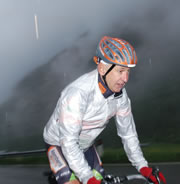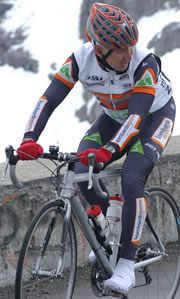Here in Northern California we just experienced a cold snap, which reminds us that we actually do have seasons here. Of course, we don’t have four seasons, but we do have two: dry and wet. Learn how to train in one or both!
Here in Northern California we just experienced a cold snap, which reminds us that we actually do have seasons here. Of course, we don’t have four seasons, but we do have two: dry (summer and fall, with cool mornings) and wet (winter and spring, when we start to complain about the cold and the rest of the country laughs at us). Even though we don’t have really cold weather and we can ride our bikes year round, we still have to deal with rain and with cold mornings. Here are a few tips (and more items to add to your holiday wish lists).
Rain
 Rain riding requires special prep before you ride, riding techniques while you ride, and maintenance after you ride.Before you ride in the rain, make sure you do the following:
Rain riding requires special prep before you ride, riding techniques while you ride, and maintenance after you ride.Before you ride in the rain, make sure you do the following:
- Make certain your tires are in good condition and drop the pressure to ~ 85-90psi.
- Install a rear fender to keep your bum as dry as possible.
- Layer your clothing and carry a rain cape.
- Wear a cycling cap w/ bill under your helmet to help keep water out of your eyes.
- Use clear or amber lenses in your glasses.
- Remember to protect and keep as warm and dry as possible your head, hands, feet, and knees (cap, insulated water resistant gloves, booties, and leg warmers).
- Make a rain vest. Cut off the arms of your rain cape (the cheap, plastic rain capes with the Velcro fronts that are about $20). If you wear the big rain cape, you may overheat quickly. Your new vest is easier to remove, and can keep your torso warm and somewhat dry.
- Additionally, while you ride, keep in mind a few guidelines.
- Avoid the paint on the road. Get the DVD of the 1993 World Championships. Watch Lance win, but also watch the pros crash as soon as their wheels touch the painted lines. Paint on the road is slick as snot! Also avoid the tar snakes and the oily parts, like the center of the lane. Riding in the tire tracks is safer.
- Don’t overheat. Remember, you don’t need to stay dry in the rain. You just need to stay warm. There is no need to attempt to stay dry, because if you do, you will probably overheat. And once you overheat, you start to sweat, which cools, and then you’re cold again. A vicious cycle.
- Put your face in it. You’re going to get wet, so just resign yourself to the fact! If you are racing or on a group ride, your face will get sprayed from the back wheel of the cyclist you’re drafting. Oh well! Don’t forget your glasses.
- Choose your route. If it’s really coming down, prepare to be creative. Modify your route to stay closer to home if it gets too bad. Another good option is to take a flatter route to stay warmer, and safer because you’ll be descending less. Remember, you get good and warm going up a climb but can get very cold on a descent when the speeds are higher and you’re not working hard. Another possibility is get on the rollers for 30-60min, then the trainer for as long as you can stand it, and then back on the rollers for another another 30-60min. If you then still need more training time and are motivated to venture into the wet, saddle up and get outside for remainder of your workout!
OK, the other un-fun part about riding in bad conditions is the BS maintenance required post-ride. Here are some helpful tips:
- If you can, at the very least, rinse your bike getting the grime off before it dries, gets hard and sticks making a thorough cleaning in the future easier. Then dry it off and lube the chain and derailleur pullies.
- Put newspaper in your shoes so they dry as quickly as possible, usually overnight.
Rinse, wipe, and dry your helmet, and glasses. - Throw all those wet and dirty important clothing items through the washer and hang dry so they’re ready for the next rain day.
Cold
 It is OK to ride in the cold ( < 45 degrees), but if only if you are prepared. One morning one athlete did a field test on the famed Canada road while it was only 30 degrees. She said that she didn’t get cold. Here’s what she had on:
It is OK to ride in the cold ( < 45 degrees), but if only if you are prepared. One morning one athlete did a field test on the famed Canada road while it was only 30 degrees. She said that she didn’t get cold. Here’s what she had on:
- Woolie Boolie socks from Defeet
- AmFib shoe covers from Pearl Izumi
- Sleeveless Pro S3 Crew from Craft (undershirt with windshell)
- AmFib Lobster gloves from Pearl Izumi
- Therma Fleece leg warmers from Pearl Izumi
- Headband ear warmer from Pearl Izumi
- SportVelo jersey
- SportVelo shorts
- SportVelo arm warmers
- SportVelo vest
- SportVelo jacket
Her strategy was to use lots of layers that she could shed to do her field test, but keep her feet and hands covered with thick gloves and arm warmers. Other people prefer thermal jackets, but I always recommend a wind vest to cover your chest. Of course, I wouldn’t really recommend attempting a field test when it’s 30 degrees out, but she was determined.
Rain and Cold
Riding in the cold (< 45 degrees) with the right clothing is OK, and riding in the wet above 45 degrees is OK with the proper preparation. But typically riding when it’s cold and wet should be limited or avoided all together. Remember, it’s still early, and the season is long. It’s better to modify a day of training or do a shorter workout inside on the trainer so that you don’t get sick, or fall because the conditions were bad. I do not want you to avoid rain riding at all costs. It’s a judgment call, and if we have a winter like 2005-6 you will have to ride in the rain. Plus, racing takes place in all conditions so having experience rain riding is important. Again, weigh the risk vs. benefit and make the call.